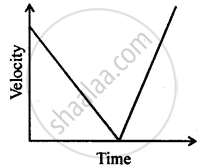Advertisements
Advertisements
प्रश्न
A stone thrown vertically upwards takes 3 s to attain maximum height. Calculate
- initial velocity of the stone
- maximum height attained by the stone. (Take g = 9.8 ms−2)
उत्तर
Initial velocity of the stone = u =?
At highest point, final velocity = v = 0
Time = t = 3s
Acceleration = a = −g = −9.8 ms−2
Maximum height attained by stone = S = h = ?
(i) v = u + at
0 = u + (−9.8) 3
u = 9.8 × 3 = 29.4 ms−1
(ii) Now, S = ut + `1/2` at2
h = `(29.4)3+1/2(-9.8)(3)^2` = 88.2 − 4.9 × 9
= 88.2 − 44.1 = 44.1 m
APPEARS IN
संबंधित प्रश्न
Define velocity. What is the SI unit of velocity ?
Name the quantity which is measured by the area occupied under the velocity-time graph.
Explain the meaning of the following equation of motion :v = u + at, where symbols have their usual meanings.
Derive the formula : v = u + at, where the symbols have usual meanings.
The slope of a speed-time graph gives:
Define velocity. State its unit.
Multiple choice Question. Select the correct option.
The speed of a car reduces from 15 m/s to 5 m/s over a displacement of 10 m. The uniform acceleration of the car is :
Can you suggest a real-life example about the motion of a body from the following velocity – time graph?

A body is thrown vertically upward with velocity u, the greatest height h to which it will rise is,
An electron moving with a velocity of 5 × 104 ms−1 enters into a uniform electric field and acquires a uniform acceleration of 104 ms–2 in the direction of its initial motion.
(i) Calculate the time in which the electron would acquire a velocity double of its initial velocity.
(ii) How much distance the electron would cover at this time?
